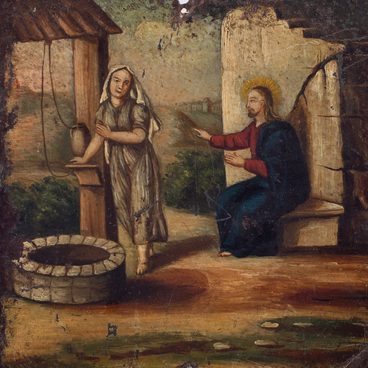Terenty Kallistratovich Perezolov was born into a family of serfs from the Nizhny Tagil factory owned by the Demidovs. In the late 18th century, the Perezolovs already had their own enterprise that manufactured and varnished iron products. After receiving a manumission, Terenty Perezolov became a merchant and studied at the Nizhny Tagil School of Painting.
In the 1820s, the factory owner Nikolay Nikitich Demidov commissioned him to paint four views of the Nizhnetagilsk factory settlement that were to be sent to Italy. One of these works has been preserved — “View of the Nizhnetagilsk Vysokogorsky Iron Mine”.
The painting was created in the genre of industrial landscape. It depicts the mining of iron ore at the Vysokogorsky Iron Mine which began operations in 1721. The mining was done using an open-pit method, as the ore was found near or even on the surface. The seasonal work at the mine was carried out from April to October.
The composition was painted on iron, a technique typical of Nizhny Tagil artists who were skilled in working with metal. This use of the iron produced at the Demidov factory served as an additional means of advertising. The image is realistic, as the artist strove to achieve verisimilitude. He paid attention to depicting the diverse mountainous landscape, the clothing and tools of the craftsmen, and the design of the carts. Ore was mined manually using only the simplest tools: pickaxes, sledgehammers, shovels, and buckets.
In the center of the painting, the artist depicted a mountainous landscape with people and horses on the benches of the quarry. In the foreground, there is a group of workers working on strengthening the slope of the quarry with logs. The open-pit mining process involved several stages, including digging, blasting, ore delivery, firing, sorting, and transportation to the factory. The digging was performed by workers in various areas of the quarry which is depicted in this painting.
The figures of the workers in the background are very small. A group of female workers can be seen walking from the pits along the benches, carrying stretchers with ore in pairs. They deliver the ore to a large pile on the left side where it will be roasted. While male serfs were forced to work at mining operations, women were often hired voluntarily.


